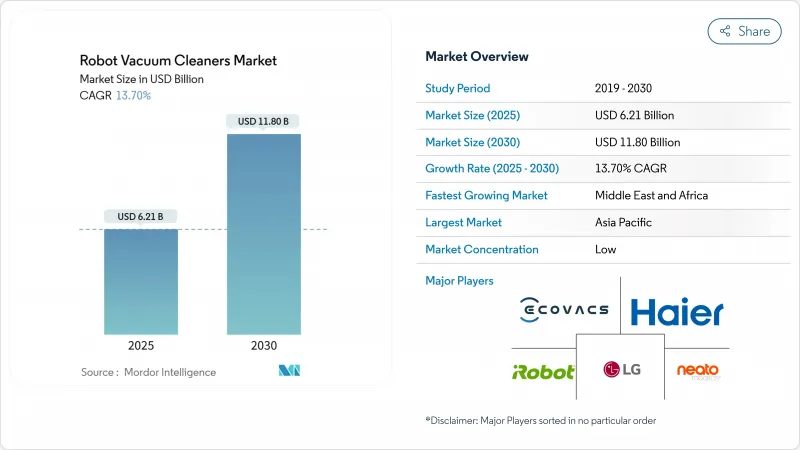
|
市場調査レポート
商品コード
1851871
ロボット掃除機:市場シェア分析、産業動向、統計、成長予測(2025年~2030年)Robot Vacuum Cleaners - Market Share Analysis, Industry Trends & Statistics, Growth Forecasts (2025 - 2030) |
||||||
カスタマイズ可能
適宜更新あり
|
|||||||
| ロボット掃除機:市場シェア分析、産業動向、統計、成長予測(2025年~2030年) |
|
出版日: 2025年07月04日
発行: Mordor Intelligence
ページ情報: 英文 120 Pages
納期: 2~3営業日
|
概要
ロボット掃除機の市場規模は2025年に62億1,000万米ドルと評価され、CAGR13.7%を反映して2030年には118億米ドルに達すると予測されています。

スマートホームの普及率の上昇、センサーとバッテリーのコスト低下、家庭内ケアの自動化を目指す人口動態のシフトが、この軌道を支える主要な力となっています。アジア太平洋地域は、デジタル化プログラムが常時接続の家電製品をサポートするインフラを促進し、日本と韓国の政策インセンティブが高齢者介護の現場での普及を促進するため、引き続き極めて重要な成長エンジンとなっています。部品価格のデフレにより、メーカー各社はLiDAR、AIナビゲーション、セルフエンプティドックをミッドレンジモデルに組み込み、消費者層を拡大します。競争激化は、スケールと迅速なイテレーションを活用してプレミアム機能を主流価格帯に導入する中国ベンダーによって再編成されます。人件費の上昇に直面するホスピタリティ事業者は、商業用不動産全体で採用を加速させる制度的な需要層を追加します。
世界のロボット掃除機市場の動向と洞察
アジアにおけるスマートホームエコシステムの急速な普及
音声アシスタントへの対応は今や基本要件であり、先進国では地域別普及率が10%を超えています。各ブランドは、衛生面や安全面での嗜好を満たすため、遠隔セキュリティ・モニタリングやAIを活用したルームマッピングなどの機能をローカライズしています。国内向けに調整されたサムスンやLGのモデルは、国の高齢者ケア・プログラムに合致させながら、現地の既存企業が中国の課題者からシェアを守る方法を示しています。
リチウムイオンとセンサー部品の急速な価格低下
LiDARモジュール、カメラ、制御ICの大量生産により製造コストが低下し、小売価格が2024年の2,000~5,000米ドルから2030年には500~1,500米ドルへと上昇します。中国ベンダーは垂直統合を積極的な価格設定に転換し、既存ベンダーはプレミアムナビゲーションやセルフクリーニング・ドックを中級ラインにバンドルすることで対応します。障壁が低くなれば、初めて購入するユーザーへの普及が促進され、既存オーナーのアップグレードサイクルも促進されます。
ディープパイルカーペット地域でのハイサクションモデルの普及率の低さ
パイルの深いカーペットでは、より高い風量と特殊なブラシが要求されるため、コストと消費電力が上昇します。20,000Pa定格のプレミアムユニットは性能ギャップに対応するが、価格に敏感な家庭には依然として手が届かないです。このような市場では従来型のアップライトが存続しており、高性能の機能がコストダウンするまで、ロボットの導入は制限されます。
セグメント分析
床用掃除機は2024年に79%のシェアを占め、一般的な床タイプで実証された有効性によってロボット掃除機市場を支えています。しかし、ハイブリッド2-in-1システムは、消費者が掃除機とモップを1台でこなせるデバイスを求めているため、CAGR17.2%で進んでいます。ECOVACSのDEEBOT T30は、絡みにくいローラーとヒーター付きモップパッドを備え、利便性とより深い清掃を融合させた設計思想を体現しています。
特に、木とタイルが混在する欧州では、ハイブリッドの普及率が向上しています。端から端までブラシが届き、自動洗浄ステーションを備えた革新的なモデルは、ロボット掃除機市場を、より広範なスマートホーム自動化への入り口として位置づけています。このような多用途性は、手作業なしで複数の家事を処理する機器を熱望するアップグレード購入者を惹きつける。
住宅購入者は、忙しい家庭に対応する大衆市場価格とアプリベースの制御により、2024年においてもロボット掃除機市場規模の91%を占めています。商業ホスピタリティは最も急成長している顧客層であり、ホテルが24時間365日の自律的なフロアケアで労働力不足を緩和していることから、年率15.4%の成長を遂げています。廊下の形状に特化したユニットや大型のゴミホッパーが、このシフトを裏付けています。
オフィスや小売施設も徐々にこれに続き、ルーティングとメンテナンスを最適化するクラウドダッシュボードから管理されるフリートが導入されています。その結果、交通パターンや清掃強度に関するデータインサイトが得られ、ロボットは単機能のツールから総合的な施設管理資産へと進化し、その価値提案を深めています。
地域分析
アジア太平洋地域は、リードタイムとコストを削減する国内製造エコシステムを活用し、2024年の世界需要の41%を占める。中国のメーカーは輸出前に自国で設計を改良し、韓国の既存企業は安全志向のユーザーに合わせたAI機能で差別化を図っています。高齢者介護ロボットに対する政府補助金は、ロボットを日常生活に組み込むことで、持続的な生産量につながります。
中東は2030年までのCAGRが18.9%で最も急成長する地域であり、高級ホテルが人員不足を補うために24時間365日の清掃を運用するようになります。埃の多い気候が大容量ろ過装置の需要を高め、高級ホテルのオーナーは性能とブランドの差別化のためにロボットフリートを採用します。
北米と欧州は高い家庭意識を示すが、異なる規制力学に直面しています。EUのバッテリーとAIに関する法規制はコンプライアンス・コストを高めるが、厳しい安全基準を満たすブランドに対する消費者の信頼を強める。ラテンアメリカでは、輸入家電製品に対する20~60%の関税が地域的な組み立て戦略を後押ししており、予測期間中にバリューチェーン投資がシフトする可能性があります。
その他の特典:
- エクセル形式の市場予測(ME)シート
- 3ヶ月間のアナリストサポート
よくあるご質問
目次
第1章 イントロダクション
- 調査の前提条件と市場の定義
- 調査範囲
第2章 調査手法
第3章 エグゼクティブサマリー
第4章 市場情勢
- 市場概要
- 市場促進要因
- アジアにおけるスマートホームエコシステムの急速な普及
- リチウムイオンとセンサー部品の急速な価格下落
- 欧州におけるハイブリッド型バキュームモップの需要拡大
- 中東高級ホテルにおけるホスピタリティ部門の自律清掃へのピボット
- 日本と韓国における高齢者介護技術への政府奨励金
- 市場抑制要因
- ディープパイルカーペット地域(米国中西部)におけるハイサクションモデルの普及率の低さ
- 電池の安全性リコールがEUのブランド信頼に影響
- 南米におけるスマート家電の高い輸入関税
- エコシステムの粘り強さを制限するブランド間ソフトウェア相互運用性のギャップ
- バリュー/サプライチェーン分析
- 規制の見通し
- テクノロジーの展望
- ポーターのファイブフォース分析
- 供給企業の交渉力
- 買い手の交渉力
- 新規参入業者の脅威
- 代替品の脅威
- 競争企業間の敵対関係
- 投資と資金調達の状況
第5章 市場規模と成長予測
- 製品タイプ別
- 床用掃除機
- プール用バキューム
- 窓拭きロボット
- ハイブリッド2in1バキュームモップ
- エンドユーザー別
- 住宅用
- 商業用
- バッテリータイプ別
- リチウムイオン
- ニッケル水素
- 接続性別
- スマートコネクテッド(Wi-Fi/音声アシスト)
- 非連結
- 価格帯別
- 200米ドル以下
- 200~499米ドル
- 500米ドル以上
- 流通チャネル別
- オンラインマーケットプレース
- ブランドeコマース
- 専門店
- 量販店およびハイパーマーケット
- 地域別
- 北米
- 米国
- カナダ
- 南米
- ブラジル
- アルゼンチン
- 欧州
- ドイツ
- 英国
- フランス
- 北欧諸国
- 中東・アフリカ
- サウジアラビア
- アラブ首長国連邦
- 南アフリカ
- その他中東・アフリカ地域
- アジア太平洋地域
- 中国
- 日本
- 韓国
- その他アジア太平洋地域
- 北米
第6章 競合情勢
- 市場集中度
- 戦略的動向
- 市場シェア分析
- 企業プロファイル
- iRobot Corporation
- Ecovacs Robotics Co. Ltd
- Roborock Technology Co. Ltd
- SharkNinja Operating LLC
- Dyson Ltd
- LG Electronics Inc.
- Samsung Electronics Co. Ltd
- Electrolux AB
- Panasonic Corporation
- Haier Group Corporation
- Cecotec Innovaciones SL
- Neato Robotics Inc.
- ILIFE Innovation Ltd
- Anker Innovations(Eufy)
- Vorwerk SE and Co. KG(Kobold)
- Miele and Cie KG
- Bissell Homecare Inc.
- HOBOT Technology Inc.
- Proscenic Technology Co. Ltd
- Hitachi Ltd
- Haeir Group Corporation

